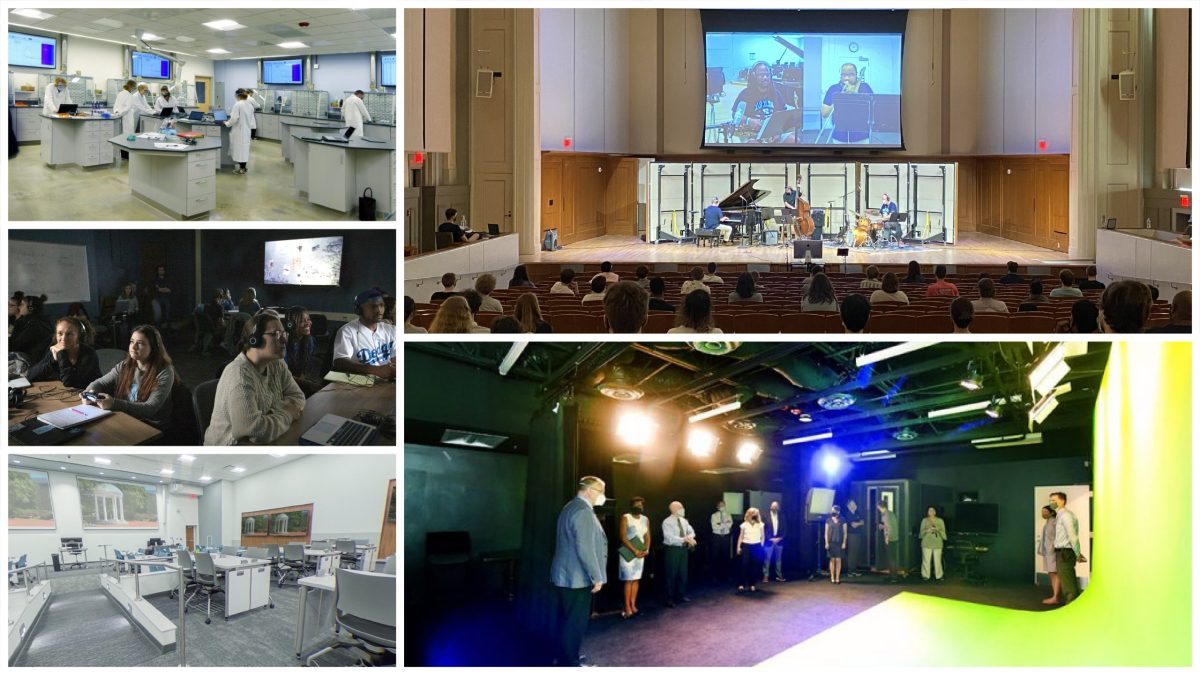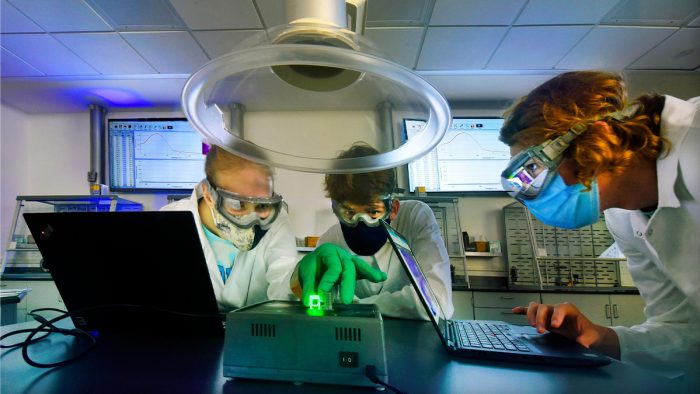Cutting-edge classrooms emerge from pandemic
In overcoming challenges caused by COVID-19, faculty and staff have added and adapted technology to improve learning flexibility in classrooms across campus.

Long before COVID-19 caused the University to pivot to remote instruction, renovations to classrooms, lecture halls and laboratories were underway to make these spaces more conducive to active and interactive learning.
“The Classroom Policy Steering Committee is looking at all 205 general-purpose classrooms across campus and trying to modernize those spaces to create a world-class environment for our students and faculty,” said Rick Wernoski, senior vice provost for business operations and chair of the committee.
During the pandemic, Higher Education Emergency Relief Fund support from the federal government helped pay for further classroom adaptations to enable remote as well as hybrid instruction. The University equipped 137 general-purpose classrooms in a dozen buildings with pan/tilt/zoom cameras and ceiling microphones.
In addition to these general changes, schools and departments had to adapt to special challenges. For example, how could faculty and students in the music department perform together when they weren’t allowed to be in the same room? Or, in the School of Government, how could local government officials struggling with the impact of COVID-19 get the information they needed without coming to classes in Chapel Hill?
Curriculum changes also spurred the creation of new learning spaces, like the English and comparative literature department’s Greenlaw Gameroom, the communication department’s Media Art Space and a host of cutting-edge classrooms in the University’s newest building, the Hussman School of Journalism and Media’s recently dedicated Curtis Media Center.
Let’s look inside some of the University’s 21st century instructional spaces:
John S. and James L. Knight Foundation Lecture Hall
This large lecture hall in the Hussman School, also known as Carroll 111, has been transformed into an active learning space similar to the 2015 pilot renovation of Greenlaw 101. Stadium-style seating is out; a new tiered floor, tables of four and learning zones divided by railings are in. So are front and side displays and software to share and display device screens wirelessly.
“The modernization of Carroll 111 is a direct result of the financial support of the Chancellor, Provost’s Office and the Knight Foundation with collaboration of faculty, staff and students to design a space that puts the pedagogy and the active learning techniques at the forefront of instructional spaces,” Wernoski said.
Music classrooms and performance spaces
“This is the future,” declared Jay Harper, the media technician who’s proud that he was able to use technology to help the College of Arts & Sciences’ music department perform live and safely during the pandemic. Now, that same technology is being adapted for other purposes including setting up livestreams in Memorial Hall and enabling multitrack recording sessions.
Working with ITS, the music department created isolated networks connecting multiple rooms in Hill Hall and Kenan Music Building and installed high quality audio and video systems that operate with minimal or no signal delay. The department also created several self-contained multimedia rolling carts with microphones, high-resolution cameras, computers and monitors that can all connect to the audio and video systems.
“Flexibility is the key. New uses are endless,” Harper said.
SOG Zoom rooms, portable Zoom and video studio

School of Government staff members set up the portable Zoom platform, a versatile “Swiss Army knife for presentations.”
The School of Government equipped 16 of its classrooms with TV screens, monitors and other technology to make them Zoom friendly in fall 2019, before the pandemic. Then with COVID-19 and the pivot to remote and/or distanced learning, the staff also looked at how to make Zoom portable for its instructors.
The school’s “portable Zoom” is a TV stand on wheels equipped with a large LED screen, a platform with an iPad controller and power strip and two built-in cameras, one for standing and one for seated presentations.
“We are constantly looking for ways to best serve our faculty members and we came up with the portable Zoom room to provide a flexible option to meet their needs. I think of it being like a Swiss Army knife for Zoom presentations,” said Jamar Jones, the school’s digital solutions and services manager. At least one instructor used the portable Zoom stand to take her classroom outside, and the school was able to transport the stand to a satellite office in the nearby mixed-use development of Meadowmont and use it for presentations for two months.
The school also renovated a 20-by-60-foot multipurpose room in its library to create an in-house video studio. With faculty members not able to travel to make in-person presentations during the pandemic, the studio allowed them to make high-quality video presentations with a choice of three backgrounds, including a green screen. School staff used the studio to film online instructional modules, messages from school administrators and school meetings.
“Our goal was to create a polished, studio-quality experience that would produce superior digital assets. We always look for ways to use technology to best showcase the talents of our amazing facility and staff,” Jones said.
Greenlaw Gameroom

In 2019, Courtney Rivard launched the DLC’s Gaming Initiative, culminating in UNC-Chapel Hill’s first game-based classroom, which opened in Greenlaw Hall in late 2019.
Launched in 2020, the Greenlaw Gameroom is the first gaming-centered classroom at Carolina, giving instructors the resources and support they need to integrate games into their classes. By providing access to costly technology as well as instruction in games and gameplay, the gameroom breaks down accessibility barriers and provides a playful space for teaching and learning with games.
The space is equipped with five large screens, five PlayStation 4s, Nintendo Switches, controllers and a growing library of games. With a seating capacity of 25, the classroom features a flexible design with moveable desks and chairs to enable all types of gaming, including tabletop games.
A key feature of the Digital Literacy and Communications Lab, the gameroom is the cornerstone of the department’s Gaming Initiative. Lab director Courtney Rivard received a $54,981 grant from the National Endowment for the Humanities to support a yearlong curricular development and faculty training program on teaching with games. The grant will lead to the development of a critical game studies minor. (Adapted from Greenlaw Gameroom website)
Lab of the Future

Students measure the fluorescence spectrum of an organic dye at the instrument table located in the Lab of the Future. (Donn Young)
The Lab of the Future, a 2021 renovation in Morehead Laboratories, sets the pace for the future of undergraduate laboratory spaces at Carolina. Thanks to a multiyear renovation project, the space nurtures collaboration, convergence and teamwork among students.
Octagonal tables placed in the center of the space encourage students to interact with each other. Monitors that line the periphery of the lab allow students and instructors to connect their laptops to instantaneously visualize and share data. (Excerpted from a story by Alice Zhao, chemistry department)
Media Art Space @ 108 East Franklin
Opened in 2021, the communication department’s new Franklin Street space unites media production and performance studies under one roof. Formerly occupied by a Walgreens store, the space will be a place for Carolina students to fuel their interdisciplinary creative projects.
A lounge area with colorful chairs and couches and a bright yellow sign invites visitors into the space — an incubation area where students can brainstorm ideas. A hallway lined with posters advertising previous student and faculty films and performances leads the way to media labs (including one outfitted with computers for game design), a studio with green screen and voice-over booth, a sound-proofed audio room, instructional spaces, a small performance space/classroom and a room for students to check out media equipment. LED lighting throughout the building will help conserve energy. (Excerpted from a story by Kim Spurr, College of Arts & Sciences






